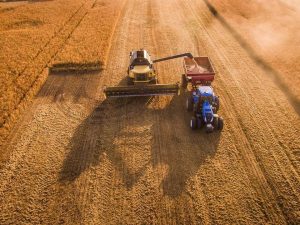According to the forecast by the Union of Agronomists in Kazakhstan, the wheat production in the country is not expected to exceed 10 million tons in 2023.
During the period from July 01 to August 23, 2023, Ukraine exported 3.832 million tons of grains (compared to 3.327 million tons by August 25, 2022), including 1.558 million tons in August (compared to 1.626 million tons in the previous year). The exports consisted of 1.597 million tons of wheat (776,000 tons), 440,000 tons of barley (145,000 tons), and 1.788 million tons of corn (635,000 tons).
According to the forecast by the Union of Agronomists in Kazakhstan, the wheat production in the country is not expected to exceed 10 million tons in 2023. The official forecast from the Ministry of Agriculture of Kazakhstan projects a production of 16 million tons.
MARS has reduced its average yield forecast for soft wheat in the EU to 5.78 tons per hectare for the third consecutive month (down from 5.8 in July), and for sunseed to 7.45 tons per hectare (down from 7.53).
In 2022/23, Poland exported a record 11.7 million tons of grain, including 5.7 million tons of wheat and 4.3 million tons of corn. Within the EU, 65% of the exported grain was sold, with Germany purchasing 4.4 million tons and the Netherlands 1.3 million tons. Nigeria imported 1.1 million tons of grain, while South Africa imported 0.6 million tons.
According to an estimate by DBV, grain and oilseed production in Germany is projected to decrease to 40.9 million tons in 2023 (down from 43 million tons in the previous year) due to prolonged rainfall during the harvesting period. Rapeseed production is expected to be 4.07 million tons (-4.9%), and winter barley production is projected at 9.5 million tons (+9.1%).
According to Oil World data, biodiesel production in the United States reached 474,000 tons in July, while HVO fuel production was 598,000 tons. HVO imports in the month amounted to 164,000 tons (compared to 144,000 in June and 58,000 in July 2022), and biodiesel imports were 101,000 tons (compared to 137,000 and 29,000). From the beginning of 2023, a total of 7.38 million tons of both fuels were produced in the US (compared to 5.55 million tons), including 3.19 million tons of biodiesel and 4.19 million tons of HVO.
According to Conab data as of August 19, 2023, the harvesting campaign of the second corn production in Brazil has been completed on 79% of the areas (+7% for the week and 90% compared to the previous year). Wheat harvesting has been completed on 5% of the total areas (+1% for the week and 4% compared to the previous year).
According to government data, soybean processing in Argentina was 2.5 million tons in July (-17% compared to July and -26% compared to July 2022). Soyoil production reached 493,020 tons (-15% and -26%), while soymeal production was 1.8 million tons (-14% and -28%). Soybean processing from the beginning of the year amounted to 17.5 million tons (-25%), soyoil production was 3.3 million tons (-27%), and soymeal production was 12.7 million tons (-24%).
The Chinese company Wellhope Foods Company Ltd predicts that soybean imports to China in 2023 will reach 100 million tons. This might be the peak of soybean consumption, as the younger population in China prefers chicken over pork.
According to estimates by China’s customs service, corn imports in July reached 1.7 million tons (+9% compared to July 2022). Total imports for the season are 13.7 million tons (-9%). Wheat imports for the month were 710,000 tons (-9%), barley imports were 720,000 tons (+20 times), and sorghum imports were 450,000 tons (-66%). Since the start of the season, wheat imports have been 8.7 million tons (+52%), barley imports have been 5.8 million tons (+53%), and sorghum imports have been 2.7 million tons (-64%).
Iran’s Ministry of Agriculture announces that authorities have purchased 10 million tons of wheat from local farmers (+43% compared to the previous year). The wheat production in 2023 is projected to be 14.5 million tons (compared to 13.2 million tons in 2022).
Turkey and the UN are preparing a proposal to Russia for the resumption of the grain corridor in Ukraine. Main challenges, as before, are related to Russia’s banking payments.





